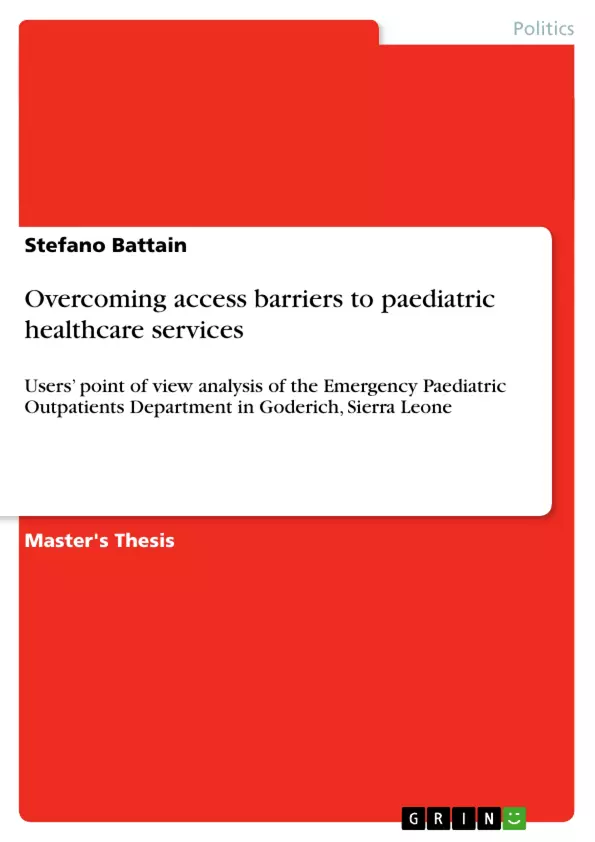In the last sixty years international institutions explicitly recognised the primary role of healthcare for people’s well being. In 1948, the United Nation in the Universal Declaration of Human Right declared that all the human beings are equal and that childhood and motherhood should be especially protected. In 1978, the World Health Organisation and UNICEF with the declaration of Alma Ata jointly confirmed that health is a fundamental human right. More recently the United Nations included in the Millennium Development Goals the goal to drastically reduce under five mortality. Despite the official documents, in Sub Saharian Africa 157 children every thousand births still die before reaching the age of five years old. Access to healthcare is the key to improve children’s healthcare but also to alleviate part of women’s daily burden. The NGO Emergency provides free healthcare also in Sierra Leone, where the rate of under five mortality is of 288/1000.
This research is a qualitative study mainly based on primary data collected during a three weeks fieldwork in Sierra Leone. It explores the factors preventing or discouraging women from accessing the paediatric service provided by Emergency in the village of Goderich. The primary data for this study were collected through twenty four semi-structured interviews, both with local women and with members of the Emergency staff.
The literature review introduces some theories used during the research such as the Gender and Development approach, the concepts of household level and care-seeking strategy and the theory of health as part of human capital. It furthermore includes a description of the main barriers to accessing healthcare service at individual, household and community level. A theoretical framework summarises the content of the literature and provides a tool to analyse the primary data. During the research it proved to be also useful to structure the checklist used for the semi-structured interviews.
The findings underline how the most important demand side barriers affecting the service are the indirect cost of accessing the service, but it should not be neglected the influence of informational, social and cultural factors. On the supply side, the strongest barrier is the attitude of part of the national medical staff working in the clinic. The final chapter answers to the research question and, based on the relevant literature, outlines some recommendations that could improve the access to the service.
Inhaltsverzeichnis (Table of Contents)
- Chapters one: Introduction
- 1.1 Rationale of the study and research objectives
- 1.2 Outline of the dissertation
- Chapter two: Literature review
- 2.1 Gender and household
- 2.2 Human capital approach to health and care-seeking strategies
- 2.3 Access and barriers to healthcare services
- 2.3.1 Demand side barriers
- 2.3.2 Demand and supply-demand interaction barriers
- 2.4 Conclusion
- Chapter three: Background
- 3.1 Sierra Leone - poverty and healthcare profile
- 3.2 Emergency in Sierra Leone
- Chapter four: Methodology
- 4.1 Data collection methods and process
- 4.2 Ethical issues, study limitations and bias
- Chapter five: Findings and analysis
- 5.1 Provider choice and demand side barriers
- 5.1.1 Demand side barriers at the individual level
- 5.1.2 Demand side barrier at the household level
- 5.1.3 Demand side barriers at the community level
- 5.2 Demand-supply interaction and supply side barriers
- 5.3 Conclusion
- 5.1 Provider choice and demand side barriers
Zielsetzung und Themenschwerpunkte (Objectives and Key Themes)
This dissertation aims to investigate the access barriers faced by users of paediatric healthcare services in Goderich, Sierra Leone. The study examines these barriers through the lens of the Emergency Paediatric Outpatients Department (OPD), exploring the perspectives of service users. The key themes explored in the study include:- The impact of gender and household dynamics on healthcare access.
- The application of the human capital approach to understanding health-seeking behaviors.
- The various demand-side barriers hindering access to paediatric healthcare, including those at the individual, household, and community levels.
- The role of supply-side barriers and their interaction with demand-side factors in shaping access to care.
Zusammenfassung der Kapitel (Chapter Summaries)
Chapter one introduces the study's rationale and research objectives, providing an overview of the dissertation. Chapter two delves into a comprehensive literature review, exploring relevant themes such as gender and household dynamics, the human capital approach to health, and various barriers to accessing healthcare services. This chapter examines both demand-side barriers, including individual, household, and community-level factors, and demand-supply interaction barriers. Chapter three presents the background of the study, focusing on the poverty and healthcare profile of Sierra Leone, including the context of the emergency situation in the country. Chapter four outlines the methodology employed for data collection and analysis, including ethical considerations, study limitations, and potential biases. Chapter five presents the findings and analysis of the study, examining provider choice and demand-side barriers, including their impact at different levels. It also explores the interplay between demand and supply factors and analyzes the influence of supply-side barriers on access to healthcare services.Schlüsselwörter (Keywords)
The dissertation centers around the themes of access to paediatric healthcare, demand-side barriers, supply-side barriers, human capital, gender and household dynamics, and the healthcare system in Sierra Leone. These keywords highlight the study's focus on understanding the complex interplay of factors that influence the ability of children in Sierra Leone to access essential healthcare services.- Arbeit zitieren
- Stefano Battain (Autor:in), 2008, Overcoming access barriers to paediatric healthcare services, München, GRIN Verlag, https://www.grin.com/document/139389



